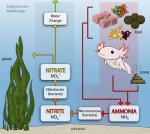lray
New member
- Joined
- Jul 22, 2011
- Messages
- 33
- Reaction score
- 0
- Points
- 0
- Country
- Australia
I am in the process of cycling my tank. I am seeding good bacteria from a fully established pond (my fathers home pond), and i also have a heater in the tank to speed things up a little. It looks amazing and clear in there - but the amonia is at a dangerous level for any life in there. My axolotls are safe in a tub of water in the kitchen until their tank is ready. Regarding the cycling process, do i just leave it be and not change any water and one day the amonia will be at a zero level? I assume as the good bacteria grows, it will consume this amonia and the tank is fully "cycled". Is this correct? Its been cycline for only a week.
I have read that when heated and seeded, a tank can be fully cycled in 10 days. Its a 100 liter tank by the way.
Any advice would be appreciated. :happy:
I have read that when heated and seeded, a tank can be fully cycled in 10 days. Its a 100 liter tank by the way.
Any advice would be appreciated. :happy:

